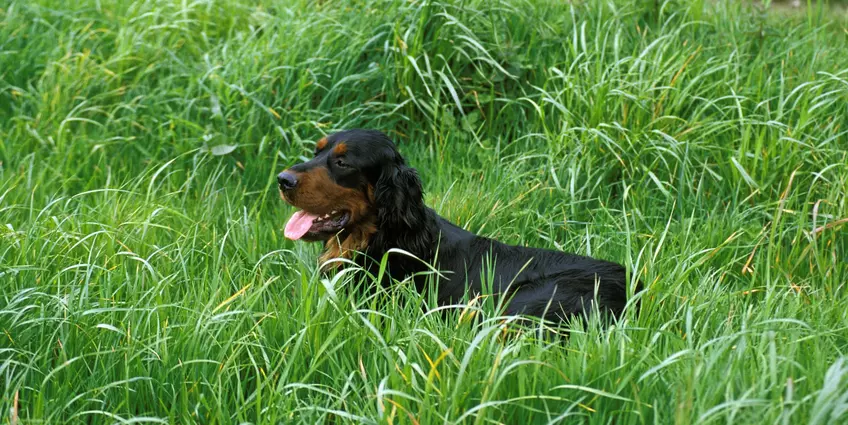Ticks on Dogs | Prevention and Treatment
- 24 Apr 2024
- 5m read

Ticks may be small, but their impact on our pets can be significant. From where they lurk to how they affect dogs, understanding ticks is crucial for responsible pup parents.
How Do Dogs Get Ticks?
Dogs can pick up ticks while exploring outdoor environments, including parks, wooded areas, and even their own garden (RSPCA). Ticks wait in grass, bushes, and other vegetation, ready to latch onto passing animals (NHS). When a dog brushes against these areas, ticks can attach themselves to the dog's fur and skin, where they then feed on the dog's blood.
Additionally, dogs can encounter ticks through contact with other animals infested with ticks, such as wildlife or other dogs (PDSA). Therefore, it's important for dog owners to be vigilant and regularly check their furry companions for ticks, especially after outdoor adventures (Blue Cross).
Are Ticks Dangerous to Dogs?
Yes, ticks can be dangerous to dogs. Ticks are known to transmit a variety of diseases, including Lyme disease, babesiosis, ehrlichiosis, and anaplasmosis (NHS). These diseases can cause a range of symptoms in dogs, including fever, lethargy, lameness, joint swelling, and in severe cases, organ damage or failure (Kennel Club UK). If left untreated, tick-borne diseases can lead to serious health complications and even death.
It's essential for dog owners to take proactive measures to prevent ticks and promptly remove any ticks found on their pets to reduce the risk of tick-borne illnesses. Regular veterinary check-ups and discussions about tick prevention strategies are also important for maintaining your dog's health and well-being (Vets Now).
What Do Ticks Look Like on Dogs?
Ticks come in various shapes and sizes depending on their species and life stage. While some ticks are as small as a poppy seed, others can grow to the size of a small grape when fully engorged with blood (PetsRadar).
These parasites have round bodies and attach themselves to your dog's skin with specialised mouthparts, making them difficult to remove without a specific technique (Blue Cross).
Where Do Ticks Hide on Dogs?
Ticks are expert hiders, preferring to burrow into warm, cosy areas of your dog's body where they can feed undisturbed. Common hiding spots include the ears, between the toes, around the tail, and in the armpits (PDSA). Regularly inspecting your pup for ticks after outdoor adventures is crucial for catching these critters before they can cause harm (Kennel Club UK).
How to Prevent Dogs From Getting Ticks
Preventing dogs from getting ticks involves several strategies to minimise their exposure to these parasites. Here are some tips for tick prevention:
Use tick prevention products
Speak to your vet about tick prevention products that are safe and effective for your dog. These may include topical treatments, collars, or oral medications designed to repel or kill ticks (PDSA).
Maintain a tidy outdoor environment
Keep your yard tidy by regularly mowing the lawn, trimming bushes, and removing leaf litter and brush where ticks may hide (Tick Bites UK). Creating a tick-free zone around your home can help reduce the risk of tick encounters for your dog (Kennel Club UK).
Avoid tick-infested areas
When walking or hiking with your dog, avoid areas known to be heavily infested with ticks, such as dense woods or tall grassy fields (NHS). Stick to cleared paths and trails whenever possible.
Perform regular tick checks
After outdoor activities, thoroughly check your dog for ticks, paying close attention to areas where ticks are likely to hide, such as the ears, between the toes, around the tail, and in the armpits (Blue Cross). Promptly remove any ticks you find using fine-tipped tweezers (Tick Bites UK).
Groom your dog regularly
Regular grooming can help you spot ticks on your dog's fur before they have a chance to attach to the skin (Kennel Club UK). Brushing your dog's coat can also help remove loose ticks and debris.
Consider environmental treatments
In areas where tick infestations are particularly problematic, you may want to consider environmental treatments such as yard sprays or landscaping modifications to reduce tick populations (PetsRadar).
Can Ticks Live on Humans?
While dogs are the primary hosts for ticks, they can also latch onto humans in search of a blood meal (NHS). However, humans are less likely to be targeted by ticks than dogs. If you find a tick on yourself after spending time outdoors, quickly remove it using the same techniques recommended for dogs (RSPCA).
Will Ticks Go Away on Their Own?
Unfortunately, ticks won't simply disappear on their own. Once they've latched onto your dog, ticks will feed until they become engorged with blood, at which point they'll drop off to lay eggs and continue their life cycle (Blue Cross). It's essential to take proactive measures to remove ticks quickly and prevent re-infestation.
How to Remove a Tick From a Dog
Removing a tick from a dog requires care and precision to ensure the entire tick is removed without leaving behind any parts that could cause infection. Here's a step-by-step guide on how to safely remove a tick from your dog:
1. Prepare
Have a tick remover tool, such as a tick twister or tick hook, on hand, along with rubbing alcohol and antiseptic wipes (Blue Cross).
2. Secure your dog
If needed, have someone hold your dog or gently restrain them to prevent sudden movements during the removal process (RSPCA).
3. Position the tick remover
Place the tick remover tool around the tick, ensuring it's as close to your dog's skin as possible (Kennel Club UK).
4. Twist and pull
With gentle pressure, twist the tick remover tool several times in one direction. This motion helps loosen the tick's mouthparts from your dog's skin. Then, slowly and steadily pull the tick straight out without jerking or yanking (PDSA).
5. Dispose of the tick
Drop the tick into a container of rubbing alcohol to kill it. Avoid crushing the tick with your fingers (RSPCA).
6. Cleanse the area
Use antiseptic wipes or solution to cleanse your dog's skin and the tick remover tool (Blue Cross).




.png)